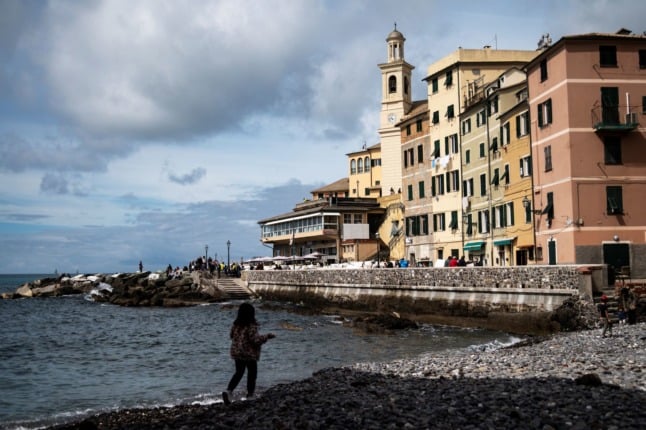Four Italian regions were placed under increased Covid restrictions on Friday, with more set to follow in the coming weeks.
On Friday evening, Italian health minister Roberto Speranza signed an ordinance designating Abruzzo, Tuscany, Val d’Aosta and Emilia Romagna as higher-risk ‘yellow’ zones from Monday.
Italy hit its highest Covid cases numbers yet on Friday, with a record 219,441 new cases registered in the space of 24 hours, according to news agency Ansa.
READ ALSO: Italian hospitals inundated with Covid patients
As the country’s infection curve continues to rise and hospitals struggle to manage their caseloads, more regions are likely to change colour over the next few weeks under Italy’s four-tiered system of coronavirus restrictions.
Under this system, ‘white’ zones are under the most relaxed rules, and ‘yellow’, ‘orange’ and ‘red’ zones are under increasingly strict measures.
As of January 7th, no regions are in the ‘orange’ or ‘red’ zone.
Abruzzo, Tuscany, Val d’Aosta and Emilia Romagna will join Calabria, Lazio, Sicily, Marche, Piedmont, Lombardy, Liguria, the autonomous provinces of Bolzano and Trento, Veneto and Friuli Venezia Giulia in ‘yellow’ zone restrictions.
Umbria, Campania, Puglia, Sardinia, Molise and Basilicata remain for now in the least-restricted ‘white’ zone.
This map shows the 15 Italian regions and autonomous provinces that will be in the ‘yellow’ zone as of Monday, January 10th:
Every Friday, Italy's health ministry reviews the latest data and decides which restrictions should be applied to each area from the following Monday. Based on current projections, it’s anticipated that several regions will be bumped up to ‘yellow’ and ‘orange’ zone status in the next few weeks.
Under a law introduced by Italy’s government in July, any region above the threshold of 10 percent ICU and 15 percent general ward Covid patient occupancy and with a new weekly incident rate of 50 cases per 100,000 inhabitants should automatically be placed in the yellow zone.
A Covid incidence rate of 150 cases per 100,000 inhabitants, combined with 20 percent ICU and 30 percent general ward Covid patient occupancy, puts a region in the orange zone; while an incidence rate of 250 cases per 100,000 inhabitants, 30 percent Covid patient ICU and 40 percent general ward occupancy sees it enter the red zone – equivalent to a full lockdown.
These parameters aren't absolute indicators: the government has discretionary powers to place an area into a higher restriction tier even if the thresholds aren't exceeded, and sometimes opts to maintain a region's lower tier status when they have. But they provide the clearest sense of where an area is headed.
Going by the latest (January 6th) figures from Agenas, Italy’s National Agency for Health Services, Liguria is currently at the highest risk of being moved into the 'orange' zone in the coming weeks.

It has a Covid patient ICU occupancy rate of 20 percent and a general hospital ward occupancy rate of 34 percent. All of Italy's regions and autonomous provinces currently have infection rates of well above 150 cases per 100,000 inhabitants, so hospital capacity is the only criterion currently being considered.
Other regions thought to be at risk of being moved into the orange zone in the next few weeks are Trento, which as of January 6th had 28 percent ICU and 19 percent general ward Covid patient occupancy; Marche (20 percent ICU, 24 percent general ward occupancy); Piedmont (22 percent ICU, 26 percent general ward occupancy), and Calabria (16 percent ICU, 34 percent general ward occupancy).
READ ALSO: Four Italian regions risk becoming ‘orange’ zones as Covid cases hit record high
11 municipalities in Calabria have already been placed in the orange zone until at least January 10th.
According to the January 6th data, Emilia Romagna had already exceeded the thresholds with a 16 percent ICU and 19 percent general ward Covid patient occupancy rate; as had Abruzzo (13 percent ICU, 19 percent general ward occupancy), Tuscany (17 percent ICU, 18 percent general ward occupancy) and Val d'Aosta, where as many as 42 percent of the region's general hospital wards and 16 percent of its ICU wards were occupied by Covid patients,
Umbria narrowly escaped a transition to the yellow zone based on its January 6th data, which exceeded both thresholds (14 percent ICU, 27 percent general ward occupancy); while Campania was at the upper limit, with 10 percent ICU ward and 20 percent general ward Covid patient occupancy rates.
Here’s a map of how Italy could look in the next couple of weeks if all the regions named above were placed into higher restrictions:
Little will change in 'yellow' and 'orange' zones for vaccinated people, as most venues and activities will remain open and accessible to those with Italy's 'super green pass' health certificate that shows the bearer is vaccinated against or recovered from Covid.
From January 10th, the 'super green pass' will be required to access all public transport and most leisure venues across the country including in 'white' zones, amounting to a nationwide lockdown for those who are unvaccinated (or aren't recovered from Covid).
In its efforts to combat the virus's spread, Italy's government on Wednesday issued a decree imposing sweeping new restrictions, including an immediate vaccine mandate for all over-50s and for staff of universities and music, art and dance training institutes.
READ ALSO: Italy to make Covid-19 vaccination mandatory for over 50s
“We are working in particular on the age groups that are most at risk of being hospitalised, to reduce pressure on hospital to save lives,” said prime minister Mario Draghi at the cabinet meeting where the measure was adopted.
In a recent interview with the radio station Rtl 102.5 Dr. Nino Cartabellotta, president of the independent research institute the Gimbe Foundation, warned Italians not to be complacent about the risk posed by the Omicron variant in overwhelming hospitals.
"It is true that the Omicron variant in a single subject can give a less serious disease, a 40% less chance of hospitalisation, but it is also true that with these numbers, if about 1% go to hospital and 1% go to hospital one thousand goes to intensive care, we are discussing very high absolute numbers," Cartabellotta said.



 Please whitelist us to continue reading.
Please whitelist us to continue reading.
Member comments